How to Grow a Tea Garden That Will Yield the Perfect Blend
If you're an herbal tea drinker, consider growing your own supplies right at home.
:max_bytes(150000):strip_icc():format(jpeg)/ms-grow-tea-garden-getty-88abcfe345f44b94af4817cdf785cd3e.jpg)
karandaev / Getty Images
Drinking tea can be a lovely way to start each morning or a restful way to end the day before heading to bed. But buying herbal teas and infusions quickly adds up. So why not grow your own tea garden instead?
Cultivating herbs for your tea is easy and requires minimal supplies—seeds or seedlings, soil, and space to plant them. "Anyone should consider growing a tea garden, and it requires very little space," says Julia Dimakos, gardening expert and blogger at The Gardening Girl. "Tea ingredients may be grown in pots, small garden containers, raised beds, or in the ground." No matter the size of your back or front yard, or if you only have a balcony or windowsill, you can grow herbs for a tea garden.
When you grow your own, there isn't any question about the herbs' quality because they are the freshest herbs possible. "Growing herbs is a great way to have fresh and organic sources of delicious and beneficial dried leaves for teas," says Carrie Spoonemore, co-creator of Park Seed’s From Seed to Spoon app. "You have complete control of the quality and freshness of your tea, without any of the additives or preservatives."
Meet Our Expert
Julia Dimakos, gardening expert and blogger at The Gardening Girl
Carrie Spoonemore, co-creator of Park Seed’s From Seed to Spoon app
Mary Jane Duford, certified master gardener, permaculture garden designer and founder of Home for the Harvest
Related: 10 Indoor and Outdoor Herb Garden Ideas That Guarantee Fresh Basil, Parsley, and More All Year Round
Best Herbs to Plant for a Tea Garden
If you're just getting started with your tea garden, try planting these easy-to-grow herbs.
Chamomile (Chamomilla recutita)
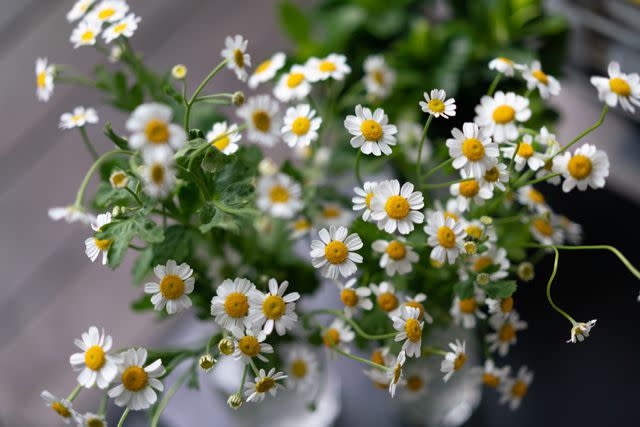
Xiuxia Huang / Getty Images
Chamomile is an easy herb to grow and has small yellow and white fragrant flowers. "Chamomile plants are low-maintenance and can thrive in full sun to partial shade, making them an excellent choice for beginner gardeners," says Spoonemore. Plant chamomile in well-draining soil and place in an area that receives six hours of sunlight each day.
Chamomile is known for its soothing properties—according to Spoonemore, chamomile can help with relaxation and promote better sleep, making it a popular ingredient for bedtime teas.
Tips
True tea, like black or green tea, comes from the tea plant, Camellia Sinensis. Technically, herbal teas are called herbal tisanes or herbal infusions—but they are commonly referred to as "tea."
Fennel (Foeniculum vulgare )
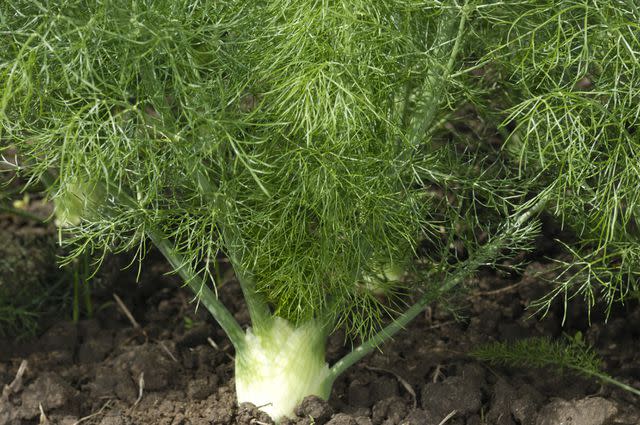
GomezDavid / Getty Images
You probably know fennel for its licorice or anise flavor, but it also makes a delicious tea. Grow fennel in a sunny area and provide a big and wide space for this plant to reach maturity. If you choose a pot, Mary Jane Duford, certified master gardener, permaculture garden designer, and founder of Home for the Harvest, recommends containers that are at least a foot wide and deep. Water fennel regularly while it's establishing itself. Once it's mature, fennel is drought tolerant. You can use the fronds, bulbs, or seeds to make tea.
Related: How to Brew the Best Iced Tea All Summer Long
Lemon Balm (Melissa officinalis)
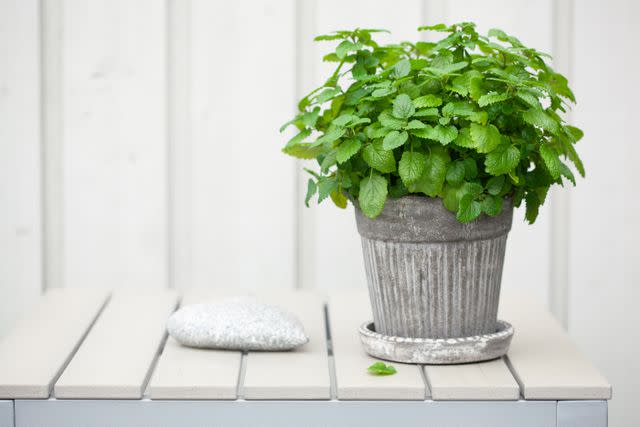
OlgaMiltsova / Getty Images
Lemon balm has a bright lemon flavor when made into tea. This herb is a perennial so it grows back each year and does best in an area with partial to full sun. A part of the mint family, plant lemon balm in a pot so the roots don't take over the garden area. "Both the leaves and flowers of the lemon balm plant may be used for tea, but the flavor is best before the plant produces flowers," says Dimakos.
Lemon balm also has some medicinal properties. "[Lemon balm] helps soothe indigestion, bloating and gas [and] is high in vitamin C and is antibacterial and antiviral," says Dimakos.
Lemon Verbena (Aloysia citrodora)
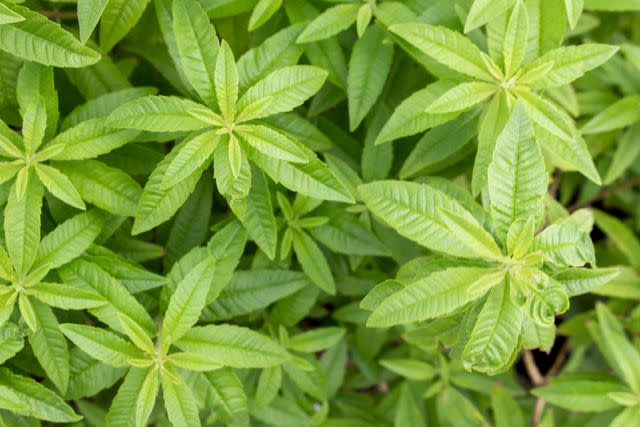
wwasilisa / Getty Images
Lemon verbena is a citrusy herb that has fragrant lemon leaves. A perennial herb, it grows in warm to hot weather and doesn't fare well in colder regions. "Lemon verbena prefers a sunny spot that receives at least 6 to 8 hours of direct sunlight daily," says Duford. "In hot climates, afternoon shade is beneficial to prevent leaf scorch." You should grow lemon verbena in a pot for two reasons: first, the root system spreads rapidly, and second, you'll want to bring it indoors during the colder months as it won't survive frost. "Containers allow mobility, ensuring the plant can be moved to optimal conditions throughout the year," says Duford.
Let the soil dry out before watering again as this prevents root rot. Lemon verbena does best when the leaves are harvested regularly, helping it grow. "Regular pruning encourages a bushier growth and prevents the plant from becoming leggy," says Duford.
Peppermint (Mentha piperita)
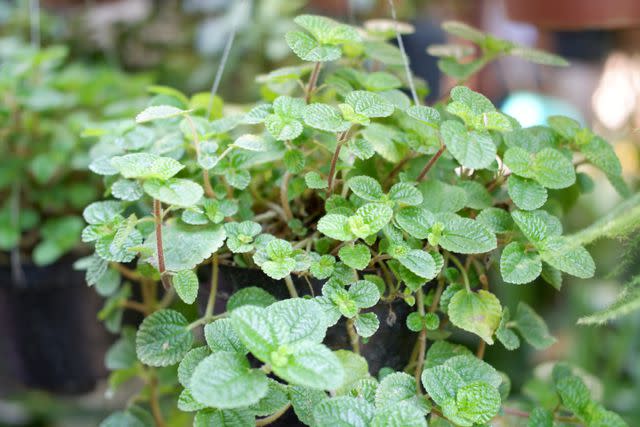
muhammad yasier / Getty Images
Peppermint is a fragrant herb that complements savory and sweet dishes and makes a delicious infusion. "The best type of soil for growing mint is an organic potting mix that is well-draining, slightly acidic with a pH level between 6.0 and 7.0," says Spoonemore. "This helps prevent root rot and other fungal diseases."
Mint does well in full to partial sunlight, or if growing indoors, put it in a south-facing window, says Duford. Make sure to grow in a container, as mint spreads rapidly and can overtake a garden area. "We love growing mint in large terra cotta pots on the front porch," says Jen McDonald, certified organic garden specialist and co-founder of Garden Girls. "It looks great year-round and smells glorious!"
Related: How to Grow and Care for Mint in Your Garden or on Your Windowsill
How to Plant a Tea Garden
You can grow a tea garden no matter how big or small a space you have. As long as the spot receives sufficient sunlight, you can grow in a raised garden bed or containers. "Find a sunny windowsill or outside location with at least four hours of sunlight per day," says McDonald. "Herbs are more forgiving than vegetables when it comes to sunlight needs."
Planting a Tea Garden in Garden Beds
Most herbs do well in a garden bed. However, some herbs like mint, lemon balm, and lemon verbena spread rapidly and can take over an area if not managed well. "Before planting in a garden bed, consider each herb’s growth habits and requirements to prevent overcrowding and resource competition," says Spoonemore.
The soil you use is key to a successful harvest. "The best type of soil for growing herbs in a raised bed garden is locally sourced sandy loam soil," says McDonald. "This type of soil is made of three ingredients: sand, silt, and clay." She explains you want to have soil that mimics where these plants would grow in nature, so it's best to purchase from a reputable nursery. Sandy loam soil retains moisture yet drains well. "While that sounds contradictory, the bottom line is that it provides the roots with just the right amount of moisture needed to grow without becoming waterlogged," says McDonald.
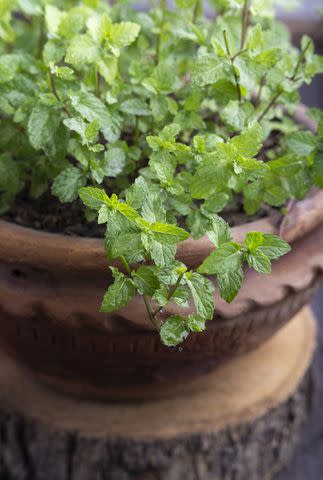
prabhjits / Getty Images
Planting a Tea Garden in Containers
If you choose to plant in containers due to spacing needs or the type of herb, consider the size. "In general, a 12–16-inch diameter is good for most herbs to thrive," says Spoonemore. "Larger or more invasive herbs may require a larger pot." Another way to decide on the size is to consider how big the foliage will be and use it as a guide. "In general, I like a potted plant’s above-ground foliage to be one to three times higher than the height [and] width of its pot," says Duford. Containers need drainage holes to allow water to drain through, preventing root rot. Drill holes if the pot doesn't have any.
You can opt for potting soil instead of sandy loam for containers. "Indoor potting soil will provide extra nutrients to plants and retain more moisture than sandy loam," says McDonald. "This is beneficial because containers dry out faster than raised garden beds."
Related: 10 Herbs You Should Stop Buying and Start Growing
How to Harvest Your Tea Garden
Herbs grow quickly, so within a month or two, you'll be ready to harvest leaves or flowers to make tea. When you're ready to make a cup of tea, you can go to your tea garden and cut a few leaves, then pour water over them and let it steep for five to 15 minutes. The longer the leaves steep, the stronger the flavor. Use clean scissors or shears to cut herbs. "A snip or two each day will actually encourage your plant to continue growing and resist bolting," says McDonald. "Just remember never to harvest more than 1/3 of the plant at one time unless you’re absolutely done growing it."
If you over-harvest an herb, the plant will not do well. "When you harvest too much at once, it sends the plant into stress mode (similar to when you trim your bangs too short!)," says McDonald. However, there is an exception—mint. "It survives just about everything," she says.
The best time of day is to harvest in the morning. "Essential oil content is highest, allowing for optimal flavor and potency," says Dimakos.
Spoonemore recommends washing the leaves thoroughly before making a cup or pot of tea.
Related: How to Grow a Windowsill Herb Garden, From Planting to Harvesting
How to Dry Herbs
You can dry herbs to use the leaves or flowers for later. "The quickest way to get your leafy herbs drying is to harvest the stems, tie the stems up in little bundles—no more than an inch thick at the tied base—and then hang them to dry upside down in a relatively dry room that has good airflow," says McDonald.
Drying herbs can take a few days on warm and hot days. In humid climates, drying can take longer, such as a couple of weeks, says McDonald. When the leaves are brittle, you know they are dry. Store leaves and flowers in glass jars. Make sure to label with plant name, variety, date harvested, and any other pertinent information.
Read the original article on Martha Stewart.

